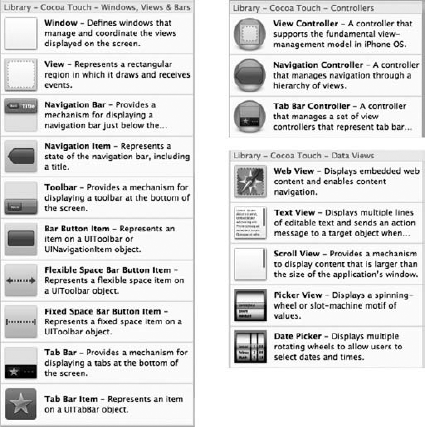Chapter 4. Data Controls
WHAT'S IN THIS CHAPTER?
Understanding windows, views, and controllers
Displaying data and editing controls
Using a toolbar
Navigating with tabs
The Interface Builder Objects Library divides the Cocoa Touch controls into four groups: Controllers; Data Views; Inputs & Values; and Windows, Views & Bars. The Inputs & Values objects were introduced in Chapter 3, and a few other objects like Tables, Maps, and Image-related controls appear in Chapters 6, 7, and 10.
These are the remaining classes, which you are going to learn about in this chapter:
Controllers
UIViewControllerUINavigationControllerUITabBarControllerUIToolBarController
Data Views
UIWebViewUITextViewUIScrollViewUIPickerViewUIDatePicker
Windows, Views & Bars
UIWindowUIViewUINavigationBarUINavigationItemUIToolbarUIBarButtonItemUITabBarUITabBarItem
Figure 4-1 shows how each of these classes appear in Interface Builder, so you know where to find them.

Figure 4-1. FIGURE 4-1
WINDOWS AND VIEWS
Windows and views form the underpinnings of all iPhone OS applications. They are the basis of the layout system and capture and handle user input. The UIWindow class in the iPhone OS is relatively simple and won't require a great deal of customization while UIView and its subclasses form the basis of every piece of your user interface.
UIWindow
An iPhone OS application generally has only one window — it provides the background upon ...
Get Professional iPhone® Programming with MonoTouch and .NET/C# now with the O’Reilly learning platform.
O’Reilly members experience books, live events, courses curated by job role, and more from O’Reilly and nearly 200 top publishers.

